Best GainsightPX Alternatives for SaaS

Exploring alternatives to GainsightPX? With plenty of choices available, it’s difficult to decide which one will be the right fit.
The crux of the issue is – to make the right choice, you need to account for your priorities: your different jobs to be done, your budget, and the size of the company. But don’t worry – we’re coming to help!
In this post, we’ll discuss exactly that – which GainsightPX competitor is best depending on the different use cases.
Let’s dive in!
TL;DR
- GainsightPX is a powerful product experience platform that helps you gather insights into how users interact with your software or app.The tool provides advanced enterprise-grade product analytics, native omnichannel engagement features to drive customer engagement, and closed-loop feedback with surveys to gauge your user experience. From NPS surveys to real-time data, GainsightPX has it all.
- GainsightPX is one of the most prominent product experience platforms in the market. However, it does have its fair share of flaws.Here are three main scenarios in which you would be better off choosing a GainsightPX alternative:
- You’re on a budget: GainsightPX isn’t the best option if you don’t have a big budget. While the pricing information is only available on request, it could cost you over $2500/month. This could be quite pricey if you’re on a budget and it’d be best to opt for a platform that’s more affordable.
- You want a more beginner-friendly platform: While GainsightPX does offer some beginner-friendly features like a WYSIWYG editor, it does have a long learning curve. If you have a non-technical background, you’re perhaps better off using a GainsightPX alternative.
- You need more extensive survey features: GainsightPX offers numerous types of surveys, including NPS. It also enables you to create multi-question survey engagements. But if you need more advanced features like behavior-based survey triggers and translations, you should opt for other platforms.
- Here are the top GainsightPX alternatives you can consider:
- Userpilot is a product growth platform that drives user activation, feature adoption, and expansion revenue. It also helps product teams collect user feedback, streamline onboarding, and gather actionable insights from analytics. With Userpilot, you’ll be able to track both product usage and user behavior to get a holistic view of how customers use your product — which will guide future development, improve the user experience, and inform your growth efforts.
- Appcues is a robust product adoption and user onboarding platform for web and mobile apps. It enables product teams to create, implement, and test personalized in-app onboarding experiences. The platform also helps you announce new product features and collect customer feedback. What makes this platform even better is the fact that it offers no-code features that make it suitable for non-technical teams.
- Pendo is a product adoption platform that lets teams monitor product usage, analyze user behavior, and publish in-app guides. The no-code solution focuses on increasing user engagement and driving feature discovery. Additionally, Pendo also lets you survey users, segment customers, and see how many site visitors or MAUs your web app is getting. Certain features like product areas, data explorer, product engagement score, and resource centers are locked to the Starter plan or higher.
- Chameleon is a product adoption platform. It enables SaaS teams to leverage real-time user data to build beautiful on-brand experiences, improve user onboarding, and drive product-led growth. In addition, it empowers product teams to create and manage dynamic in-product experiences. With Chameleon, SaaS teams can now create beautiful product tours that help, guide, and delight their users throughout their journey. All of these are possible without coding!
- Interested in driving product growth without coding? Book a demo to see how we can help!
What is GainsightPX?
GainsightPX is a powerful product experience platform that helps you gather insights into how users interact with your software or app.
The tool provides advanced enterprise-grade product analytics, native omnichannel engagement features to drive customer engagement, and closed-loop feedback with surveys to gauge your user experience. From NPS surveys to real-time data, GainsightPX has it all.
What are the main use cases for GainsightPX?
Understanding the core functionalities and use cases of GainsightPX is crucial for deciding whether or not it’s the right choice for you.
Without further ado, let’s see the primary scenarios where GainsightPX is useful for your SaaS business!
GainsightPX for user onboarding
User onboarding is a critical process that helps set an initial impression of your platform. That’s why you need to ensure that you provide the right set of resources and hand-hold your users through this phase to get them accustomed to your platform.
GainsightPX offers a few features to help you get your user onboarding right:
- You can start by creating in-app guides and target them to new users to onboard them with ease. To create one, you can click on “Engagements” in the left sidebar and click on “Create.” You can select “Guide” among the options and add a description too.
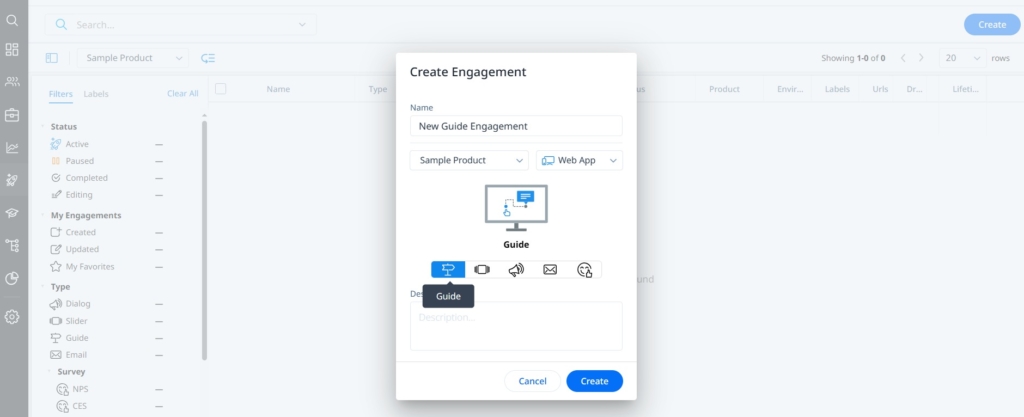
- GainsightPX gives you numerous segmenting rules based on personas, engagements, and systems to help you filter out users and show the in-app announcements to a targeted audience. You can then select a template and edit it to create your in-app announcement. GainsightPX offers tooltips, hotspots, dialog boxes, and more. Finally, you can schedule your in-app announcement and publish it.
- Create an extensive knowledge base with Knowledge center articles and bots. You can click on “Knowledge Center” in the left sidebar and select “Articles”.

- You can also create knowledge center bots that display a list of relevant knowledge center articles and external resources. These are essentially onboarding checklists and come in handy to help new users understand your platform. To create one, you can select “Bots” from the left sidebar and click on “Create.” You can then enter the name of the bot and describe it.
- You can select the audience by filtering it for various parameters and segment the users with multiple AND-OR rule logic filters. After that, you can add the content for your knowledge center bot. Finally, you can edit the look of the knowledge center bot and launch it.

GainsightPX for product analytics
GainsightPX is purpose-built for product analytics and has loads of analytics options that can help you get an idea of how your product is being used.
Here’s how you can go about product analytics:
- You can use the retention analysis feature to find out which features of your platform are driving retention by analyzing selected cohorts. It’s possible to filter the cohort size, date range, and first and returning events to get a detailed insight into your retention.

- You could also use the path analysis feature offered by GainsightPX to see how users navigate through your platform. It can help you identify potential roadblocks so you can eliminate them to improve the product experience for your users.
- Another feature that can come in handy here is the adoption feature that enables you to see how well a particular feature was adopted by an active cohort.
GainsightPX for self-service support
As a product adoption platform, GainsightPX lets you integrate self-service support into your product. All you have to do is create and launch a knowledge center bot. Here’s how you can do that:
- You can build an in-app help center for self-service support and use AND/OR rule logic filters to refine your audience.
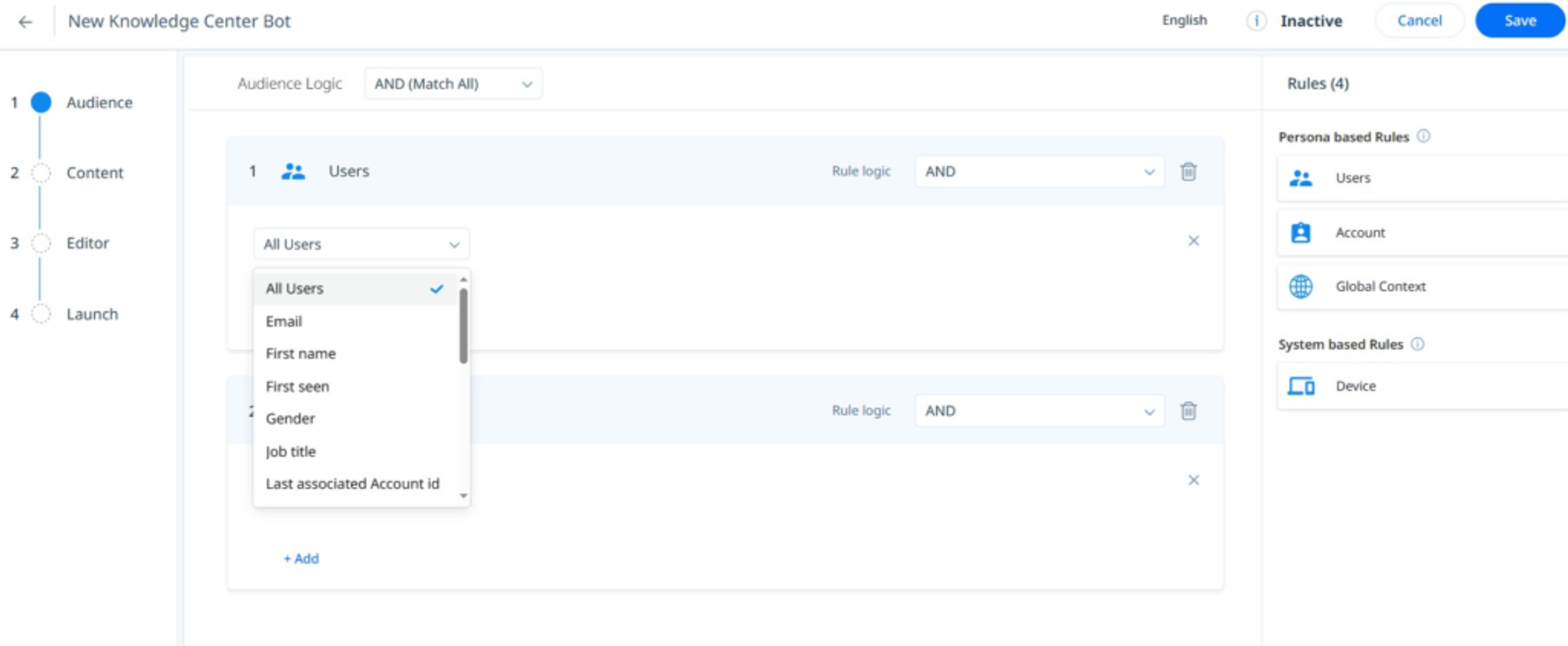
- You can include existing knowledge center articles, in-app engagements, and external resources. Additionally, you can highlight relevant content using the Recommendation feature. It’s an excellent tool to showcase important product tutorials, tooltips, and articles to handhold the user.

- You can also enable the feedback option in the Feedback tab to let users request new features, submit queries, or share their general experience of using your product.
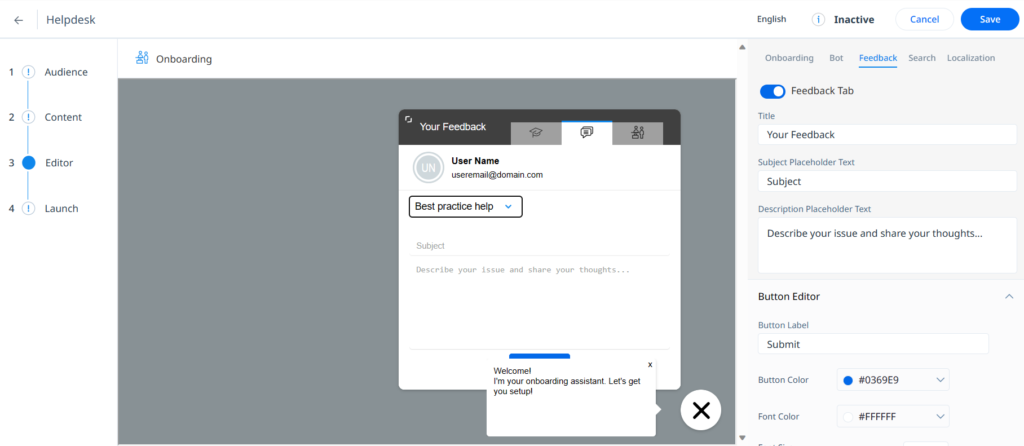
- Lastly, click Launch to get your always-available knowledge center bot up and running.
- Besides knowledge center bots, GainsightPX also lets you create walkthroughs, dialog boxes, and tooltips to help users get the hang of your product.
What are the pros and cons of GainsightPX?
Pros of GainsightPX?
As a prominent product experience platform, GainsightPX offers several valuable features that can help you elevate your user experience. Let’s see why it stands out.
- Powerful segmentation: GainsightPX excels when it comes to segmentation. You can easily segment your audience into groups based on behavior, demographics, and other parameters to personalize their experience.
- Beginner-friendly: You have a WYSIWYG editor that helps you build product tours, in-app guides, and other UI elements that can help you engage your users and improve their experience. The ease of creating these makes the platform great for non-technical users.
- Powerful analytics: GainsightPX offers built-in analytics features that help you track key user engagement and behavior metrics. You can easily find trends and understand your customers better through the platform to elevate their experience further.
- Knowledge center: You can elevate user experience by leveraging the knowledge center bot offered by GainsightPX. It guides users on how to use your product by providing all the necessary links needed (including external ones). This, paired with knowledge center articles, makes for a great user experience.
- Easy feedback collection: GainsightPX makes it simple to create feedback surveys with multiple question types to gauge user requirements and feedback. You can create NPS, CES, Boolean, and numerous other types of surveys.
Cons of GainsightPX?
While GainsightPX provides powerful product experience features, there are a few areas where it lags behind. Let’s take a look at them in detail.
- Long learning curve – GainsightPX offers some beginner-friendly features, but you need to spend some time using the tool before you can get the hang of it. The steep learning curve can make it difficult for beginners to use the platform to its fullest.
- Basic analytics – While the analytics feature offered by GainsightPX is powerful, it can get difficult to drill deeper into the data due to the numerous dashboards and widgets. It lacks predictive analytics features too.
- Limited integrations – GainsightPX offers a handful of integrations with third-party platforms. This makes it difficult to simplify workflow with your existing tech stack. It’d help if the number of integrations could be increased.
- In-app screen recording – GainsightPX doesn’t have an in-app screen recording feature that can help you see how users interact with your product. This feature could, otherwise, come in handy to understand how to elevate the user experience.
What do users say about GainsightPX?
GainsightPX has a great rating of 4.4 stars (out of 5) on G2. It also has a rating of 4 (out of 5) on Capterra. Users mostly praise how the platform offers numerous options for building engagements and understanding user behavior.
Here’s what a GainsightPX user had to say:
“GainsightPX has been a really powerful tool for engaging with our customers” There are a lot of options for how we can build engagements, the tool helps us fulfill a number of tasks concerning enhancing the Customer user experience and being able to communicate with them in a timely manner through an appropriate channel. Like most B2B we have an over-reliance on email as a comms channel for both product adoption, training, and wider marketing comms. Gainsight has helped us an entirely new channel to communicate with customers via. Rob W., Marketing Manager (Enterprise)
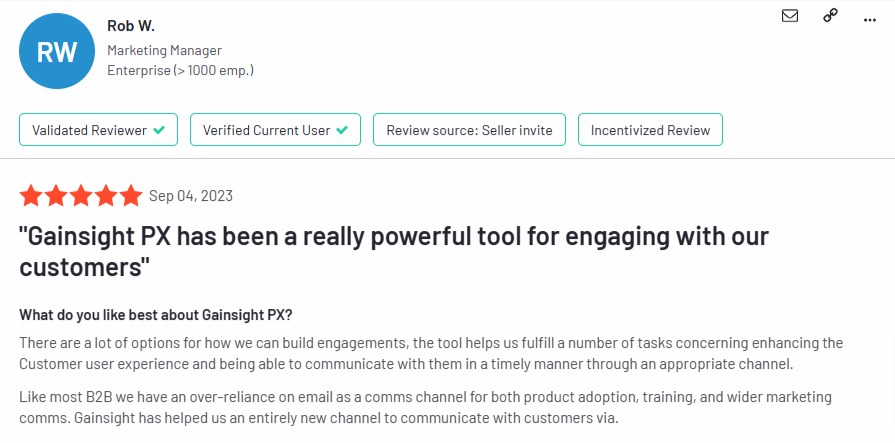 While a majority of users have given stellar ratings to GainsightPX across review sites, there are some who complain about its missing features and funnel functionality.
While a majority of users have given stellar ratings to GainsightPX across review sites, there are some who complain about its missing features and funnel functionality.
Here’s what one of the users had to say:
Previously I tried Hotjar and compared to it – there are some features missing. I really miss a real heatmap (the heatmap that Gainsight provides is not very graphical) or the possibility to see the recordings of my users actually using the platform (there is such an option of some sort of an addon to turn on but turning it on doesn’t really do anything to me and the recordings doesn’t show). I can create a funnel showing me how my users interacted with the website but only 10 positions can be present in one column. Therefore I have nine options showing and a big block named “Other”. Since the amount of “other” visited is pretty significant (often the biggest number on every step) it really affects the results. Pawel M., Trainer (Mid-Market)
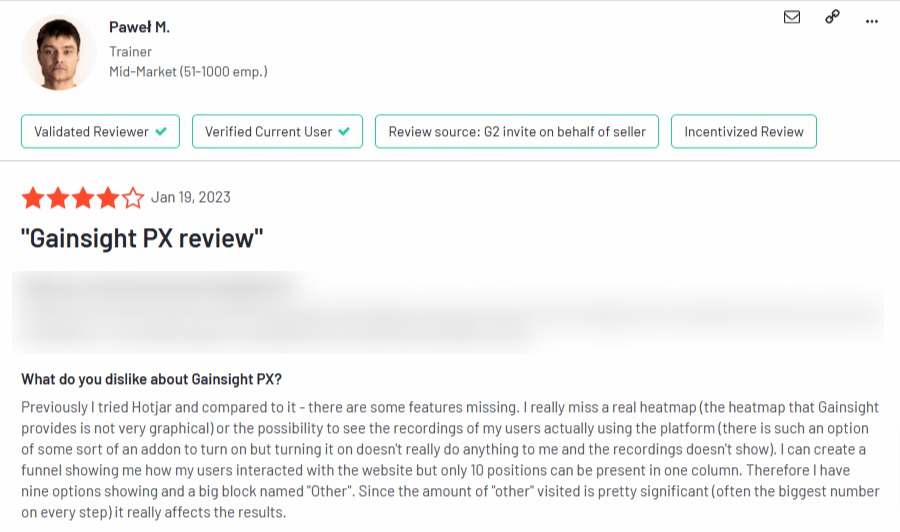
Does GainsightPX fit your budget?
Pricing details for GainsightPX aren’t readily available. Instead, you have to request them by filling out a form. The final pricing of the platform will depend on your requirements.
That said, you can get a 30-day free trial of the platform with ease. You could also request a free demo of the platform.

3 Reasons why you might need a GainsightPX alternative
GainsightPX is one of the most prominent product experience platforms in the market. However, it does have its fair share of flaws.
Here are three main scenarios in which you would be better off choosing a GainsightPX alternative:
- You’re on a budget: GainsightPX isn’t the best option if you don’t have a big budget. While the pricing information is only available on request, it could cost you over $2500/month. This could be quite pricey if you’re on a budget and it’d be best to opt for a platform that’s more affordable.
- You want a more beginner-friendly platform: While GainsightPX does offer some beginner-friendly features like a WYSIWYG editor, it does have a long learning curve. If you have a non-technical background, you’re perhaps better off using a GainsightPX alternative.
- You need more extensive survey features: GainsightPX offers numerous types of surveys, including NPS. It also enables you to create multi-question survey engagements. But if you need more advanced features like behavior-based survey triggers and translations, you should opt for other platforms.
Better alternatives to GainsightPX
Considering alternative options to GainsightPX can often lead to discovering more tailored solutions that better suit your needs. Here are the top GainsightPX alternatives you can consider:
- Userpilot is a product growth platform that drives user activation, feature adoption, and expansion revenue. It also helps product teams collect user feedback, streamline onboarding, and gather actionable insights from analytics. With Userpilot, you’ll be able to track both product usage and user behavior to get a holistic view of how customers use your product — which will guide future development, improve the user experience, and inform your growth efforts.
- Appcues is a robust product adoption and user onboarding platform for web and mobile apps. It enables product teams to create, implement, and test personalized in-app onboarding experiences. The platform also helps you announce new product features and collect customer feedback. What makes this platform even better is the fact that it offers no-code features that make it suitable for non-technical teams.
- Pendo is a product adoption platform that lets teams monitor product usage, analyze user behavior, and publish in-app guides. The no-code solution focuses on increasing user engagement and driving feature discovery. Additionally, Pendo also lets you survey users, segment customers, and see how many site visitors or MAUs your web app is getting. Certain features like product areas, data explorer, product engagement score, and resource centers are locked to the Starter plan or higher.
- Chameleon is a product adoption platform. It enables SaaS teams to leverage real-time user data to build beautiful on-brand experiences, improve user onboarding, and drive product-led growth. In addition, it empowers product teams to create and manage dynamic in-product experiences. With Chameleon, SaaS teams can now create beautiful product tours that help, guide, and delight their users throughout their journey. All of these are possible without coding!
Let’s see the features and functionalities of these tools for different use cases!
GainsightPX vs Userpilot
There are many ways how Userpilot is different (and in a lot of ways better!) from GainsightPX. Let’s explore the features of Userpilot, how it’s better than GainsightPX, and how it may fall short too.
Userpilot for user onboarding
User onboarding is a crucial part of the customer journey as it speeds up the adoption process and increases retention rates. Onboarding is one of Userpilot’s core use cases along with product growth analytics and user feedback, so it has plenty of features that you can utilize.
Here are some Userpilot features you can use when onboarding new users:
- No-code builder: Creating flows with Userpilot is as simple as installing the Chrome extension, selecting the UI patterns you’d like to use, and then editing the content/settings to suit your use case. You can also use templates to create modals, slideouts, tooltips, and driven actions.

No-code flow builder in Userpilot.
- Native tooltips: Userpilot lets you create native tooltips that show up when users hover over an element or click on an information badge. Since these native tooltips attach to the element itself, they aren’t page-dependent and will show up on any screen where that element is visible.

Build native tooltips with Userpilot.
- Advanced flow settings: With advanced condition settings, you can decide when, where, and who you’ll be triggering your onboarding flows. This helps you create contextual and personalized onboarding experiences that drive engagement and adoption.
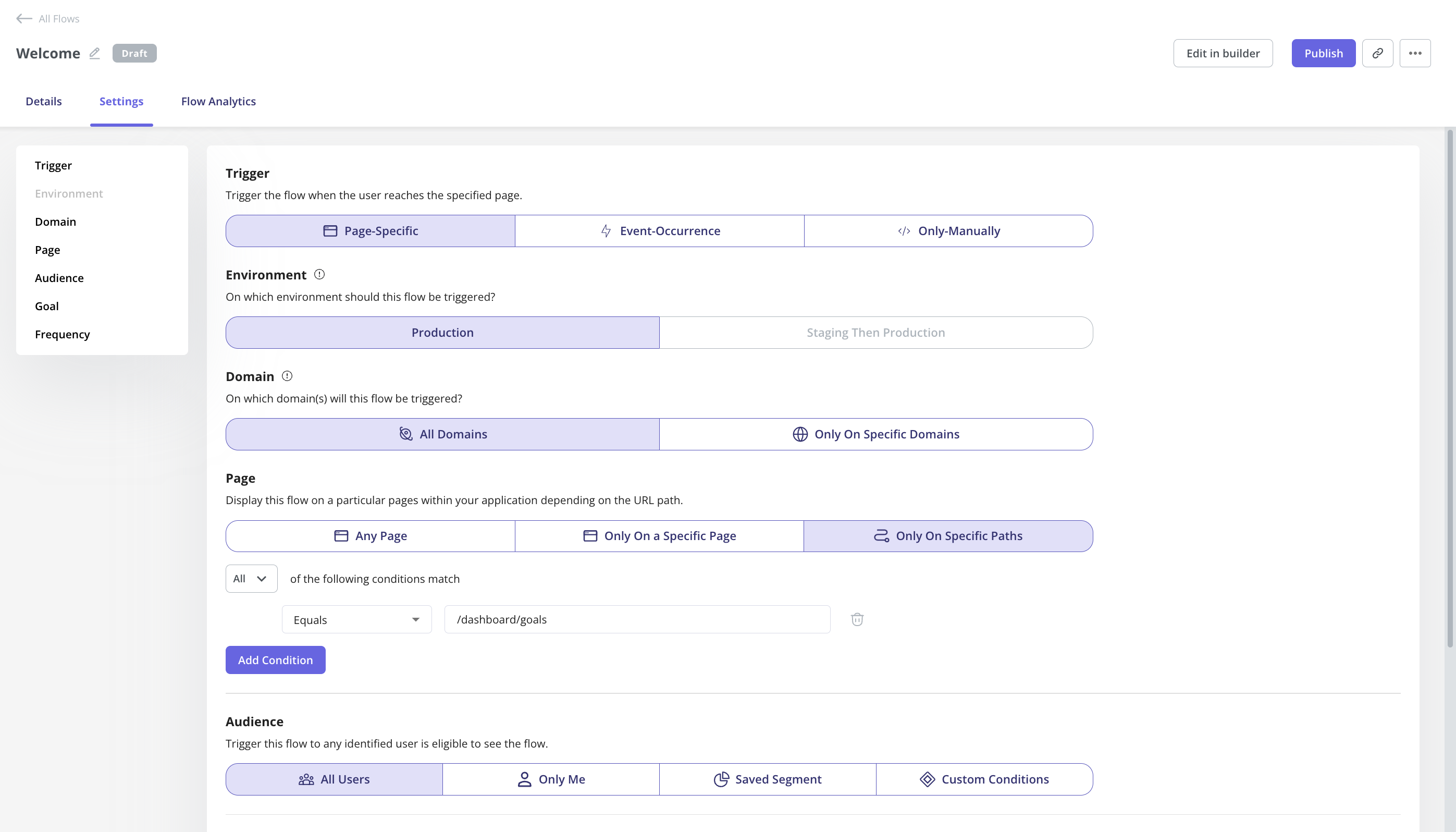
- Onboarding engagement analytics: You can easily assess the impact of your onboarding flows, guidance, etc. by analyzing the engagement rate of tooltips, interactive walkthroughs, checklists, etc. In addition, you can also build reports (funnels, paths, etc.) or dashboards to track your core onboarding metrics i.e. activation, stickiness, drop-offs, etc.
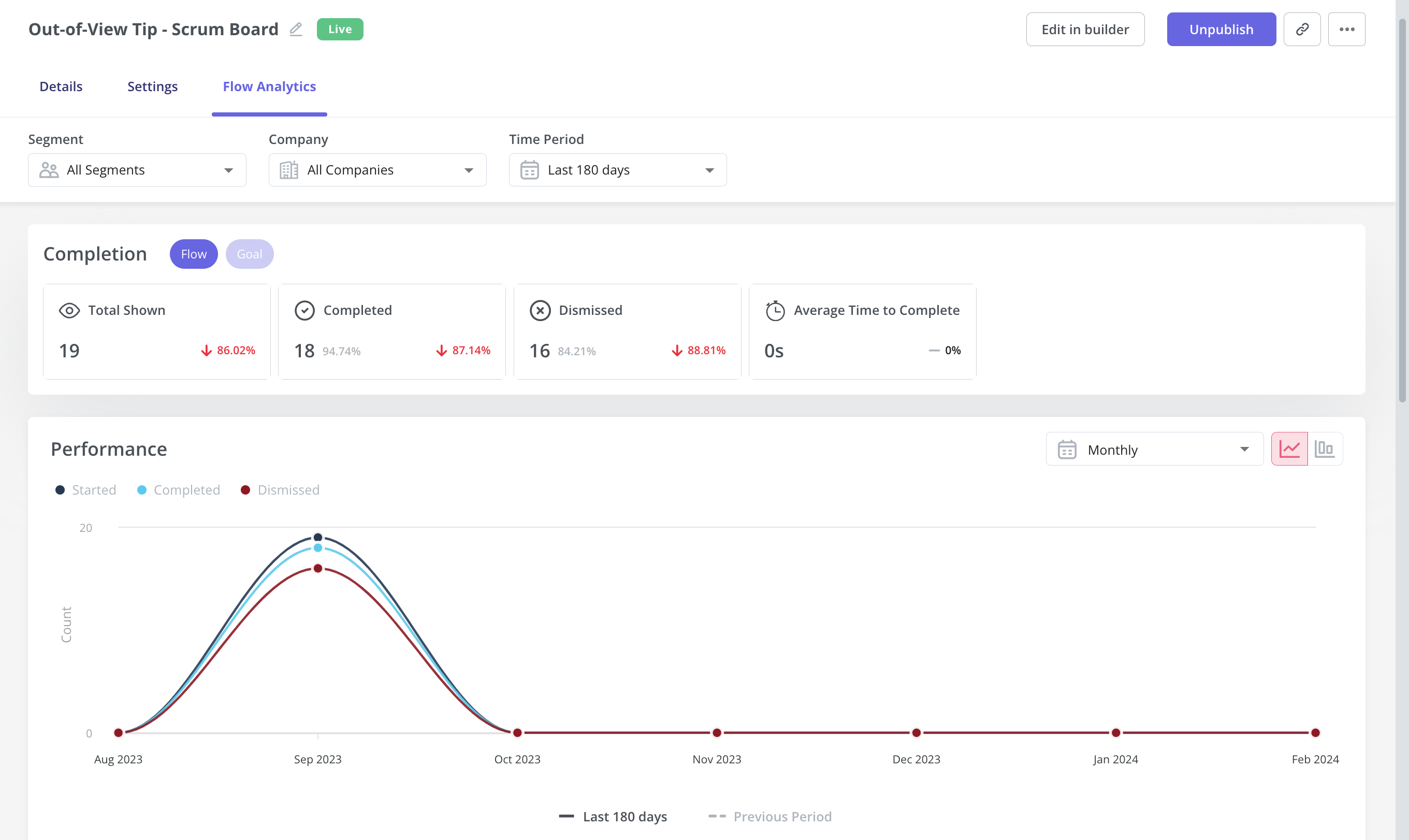
Userpilot for product analytics
Product analytics lets you collect and analyze data about how users interact with your product so you can extract actionable insights. Userpilot lets you look at granular product analytics, such as which features have the highest adoption rates, and big-picture insights like trend reports. Here are Userpilot’s top product analytics features:
- Feature tagging: Userpilot’s click-to-track feature tagger lets you view how many times a feature has been used and by how many users to measure its adoption. Users on the Starter plan can add up to 10 feature tags while those on the Growth or Enterprise tier can create unlimited tags.
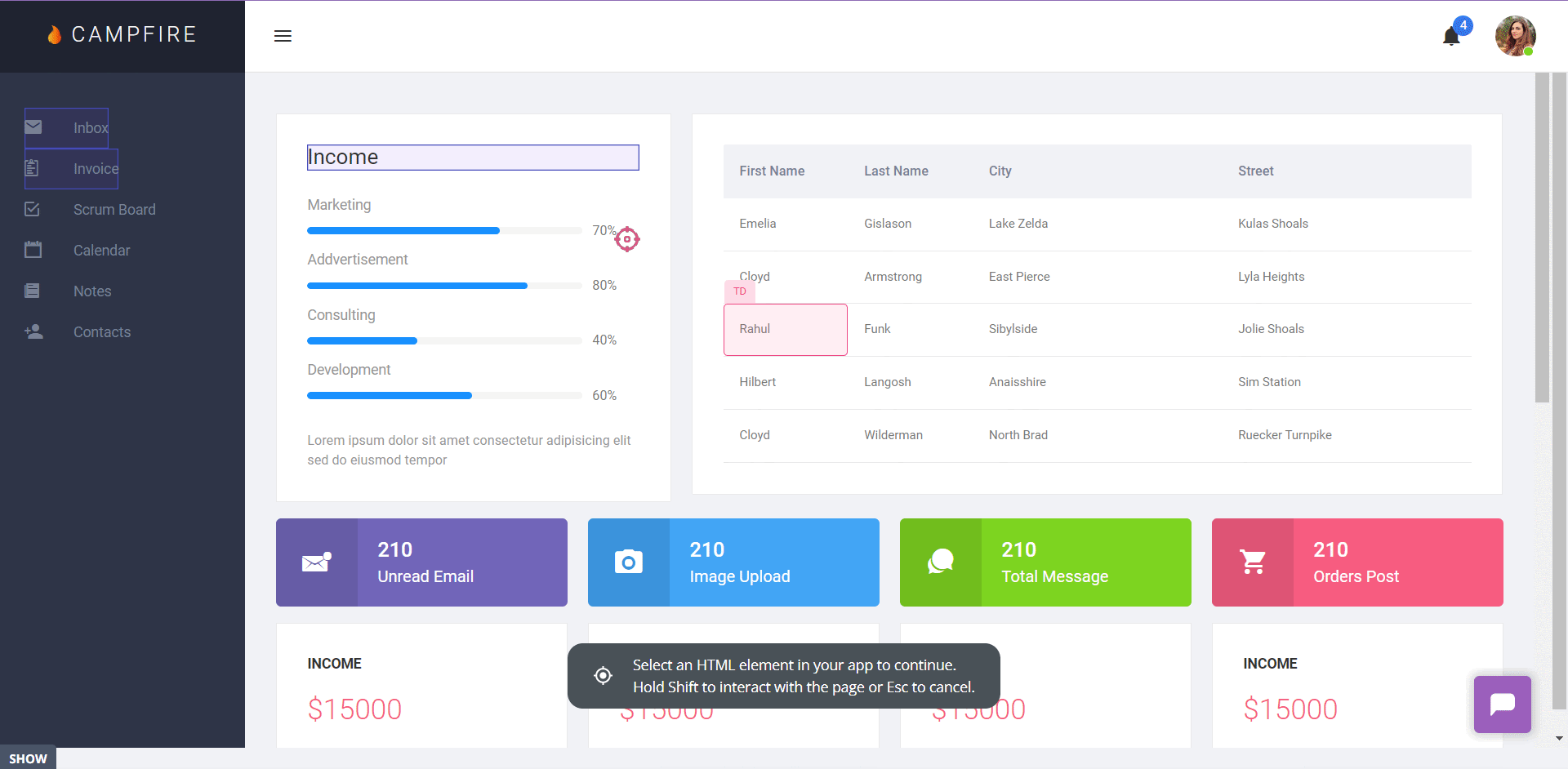
No-code feature tags in Userpilot.
- Event-tracking: Alongside no-code feature tags for feature engagement tracking, you can also track other events unique to your product using event-tracking. You can also create a group of events to track a specific process i.e. onboarding, subscription, etc.
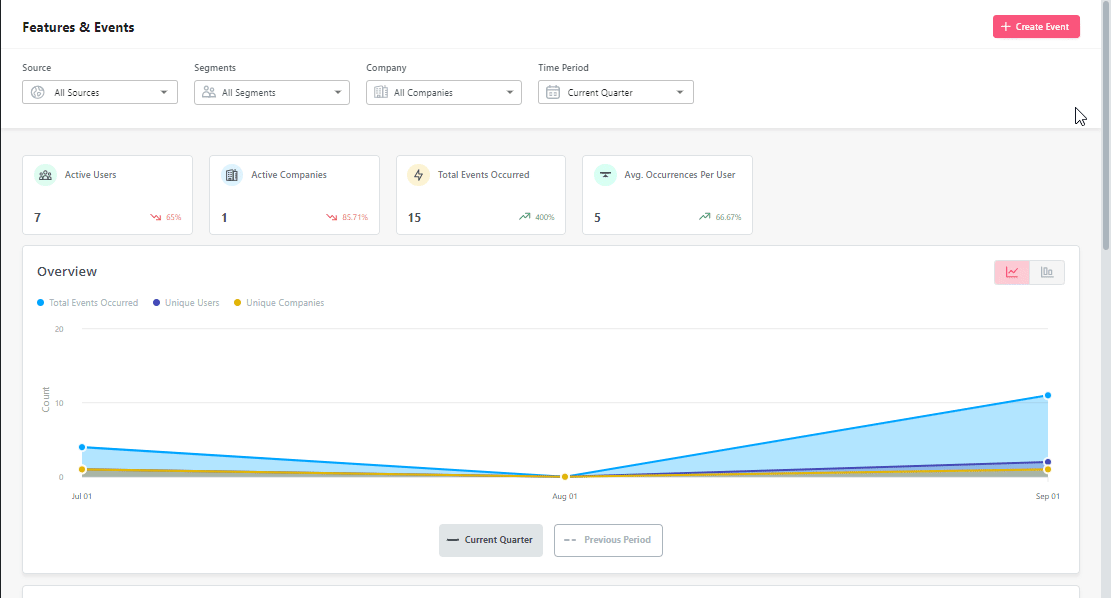
Create tracked events to monitor server-side data.
- Trends and funnels: Userpilot’s trends and funnels report lets you extract actionable insights from big data. You’ll be able to see which stage of an onboarding/conversion funnel most users drop out on and create trend reports with detailed breakdowns by user or period.
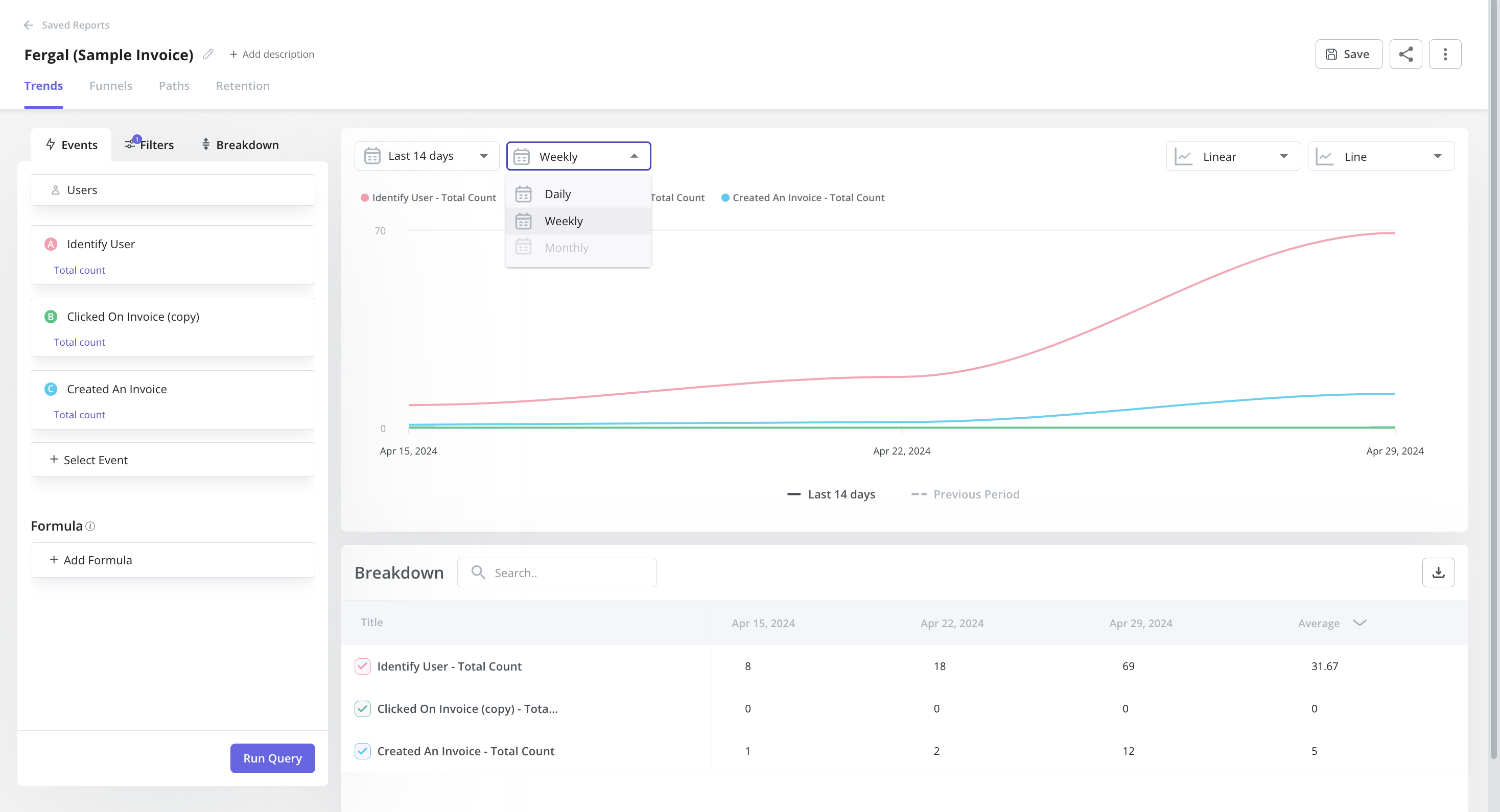
Example of a trend report in Userpilot.
- Retention tables: This lets you gauge product performance – how effective it is at retaining users using cohort tables and retention curves.
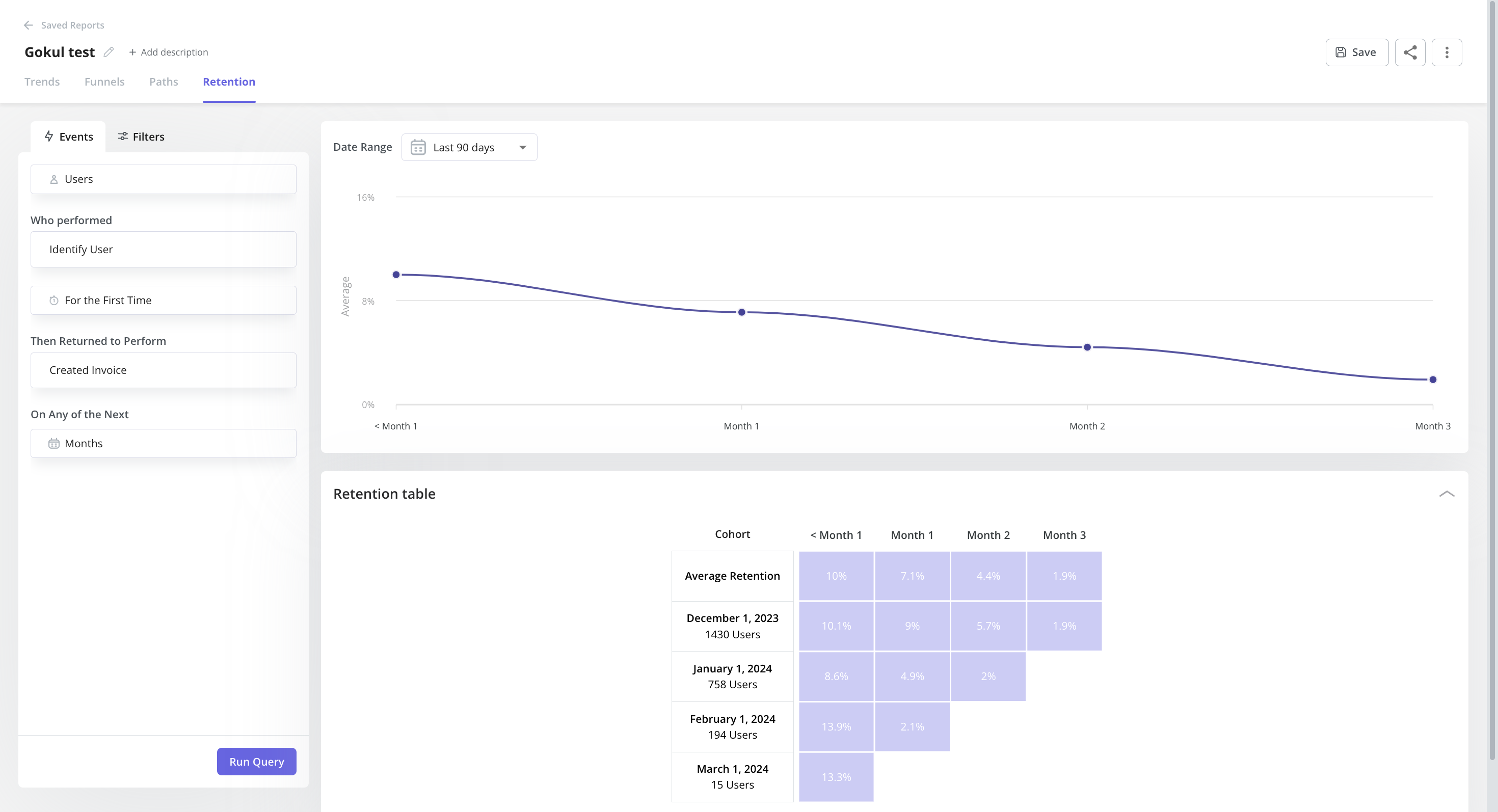
- Paths: You can generate and access path reports directly within the reporting builder in Userpilot, alongside funnels, trends, and retention reports. With Paths, you can have an overview of how users navigate your product features – offering invaluable insights into their interactions with your products.

- User & Company profiles: Here you can view data related to a certain user/company to gain insights into their behavior and improve the overall user tracking experience. This helps you understand how they engage with your product or platform, better identification of areas of improvement, and tailor their offerings more effectively.

ser profile with top event data that provides insights into what feature they regularly engage with.
- Analytics dashboards (Product Usage, New Users Activation, Core Feature Engagement, User Retention, etc.): These dashboards enable you to keep track of your key product performance and user behavior metrics at a glance, without any technical setup required.

- Analytics integrations: Userpilot integrates with some of the most popular analytics tools like Amplitude, Mixpanel, Segment, Google Analytics, and more. This makes it possible to sync product analytics both ways between the tools in your tech stack (two-way integration is only available for Hubspot at the time of writing, more to come).

Userpilot for self-service support
Here’s how you can use Userpilot to create a self-service customer experience:
- No-code builder: Userpilot’s no-code resource center lets you add modules without writing a single line of code. Module options include links, videos, flows, custom JavaScript functions, and checklists. You can also group modules into sections to help users navigate the resource center.

Add different types of content to your resource center.
- Module segmentation: Userpilot’s segmentation settings let you hide or show specific modules within your resource center based on audience settings. This makes it possible to create modules for different user segments and hide resources that aren’t relevant to other users.
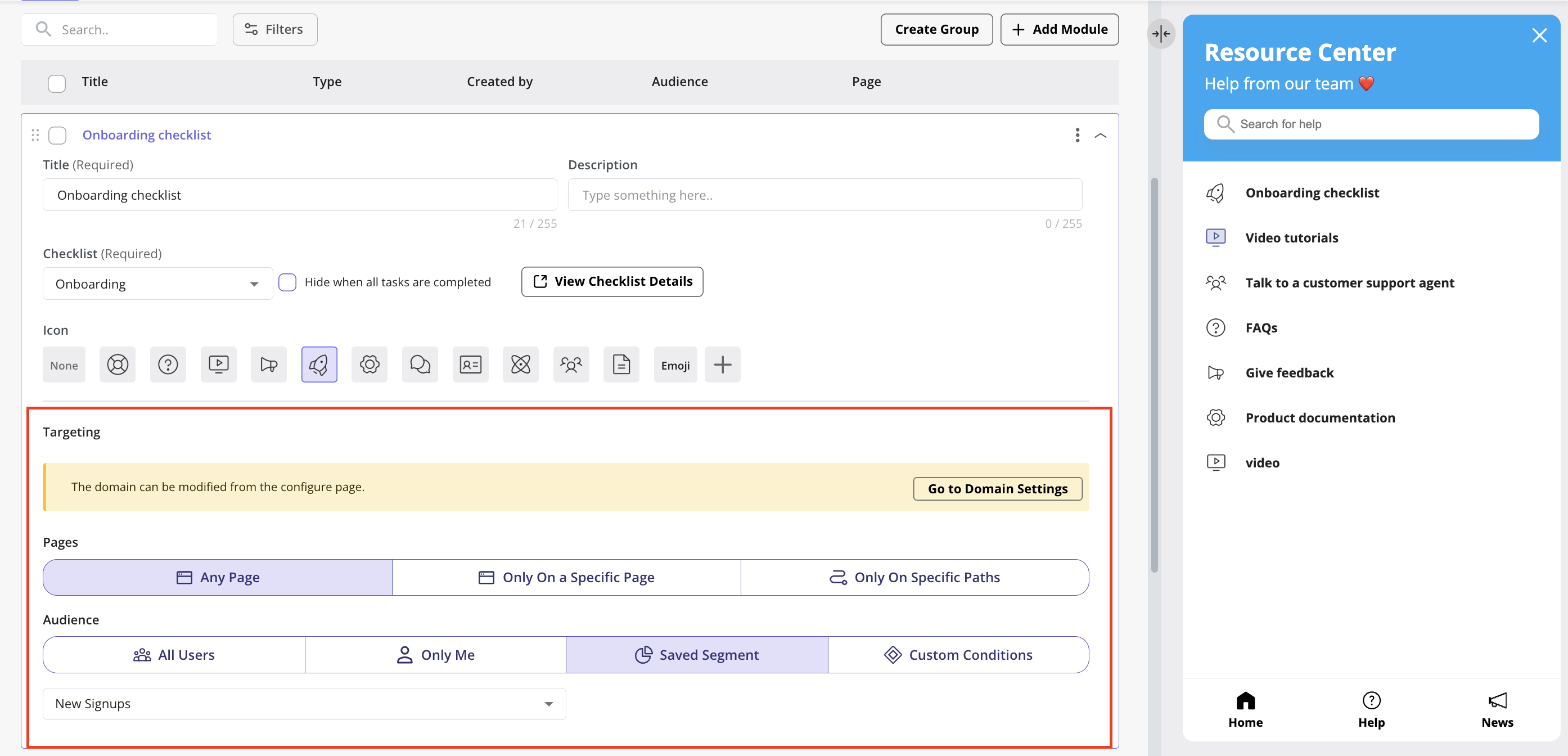
Help module visibility condition settings.
- Resource center analytics dashboard: The dedicated analytics dashboard helps you see how many unique visitors your resource center gets, how many modules have been clicked, the overall click rate across your user base, and popular search terms. This will make it easier to gauge resource center performance and identify if anything is missing from your resource center.

Resource center content analytics in Userpilot.
Pricing of Userpilot
Userpilot’s transparent pricing ranges from $249/month on the entry-level end to an Enterprise tier for larger companies.
Furthermore, Userpilot’s entry-level plan includes access to all UI patterns and should include everything that most mid-market SaaS businesses need to get started.

Userpilot has three paid plans to choose from:
- Starter: The entry-level Starter plan starts at $249/month and includes features like segmentation, product analytics, reporting, user engagement, NPS feedback, and customization.
- Growth: The Growth plan starts at $749/month and includes features like resource centers, advanced event-based triggers, unlimited feature tagging, AI-powered content localization, EU hosting options, and a dedicated customer success manager.
- Enterprise: The Enterprise plan uses custom pricing and includes all the features from Starter + Growth plus custom roles/permissions, access to premium integrations, priority support, custom contract, SLA, SAML SSO, activity logs, security audit, and compliance (SOC 2/GDPR).
GainsightPX vs Appcues
There are many ways how Appcues is different (and in a lot of ways better!) from GainsightPX. Let’s explore the features of Appcues, how it’s better than GainsightPX, and how it may fall short too.
Appcues for user onboarding
Onboarding new users seamlessly is one of the primary use cases of Appcues. The platform offers a wide array of features to help you improve user activation, conversion, and retention.
Let’s take a closer look at how Appcues facilitates new user onboarding:
- Drag-and-drop builder: Appcues’s no-code builder lets you create personalized onboarding tours and checklists to assist and educate new users. You can customize UI patterns like hotspots, modals, slideouts, and tooltips to guide users.
- In-app user guides and product tours: You can use various UI patterns, such as hotspots and tooltips, to introduce new users to product features in a pre-defined sequence. Similarly, you can use checklists to guide users as they explore your app.
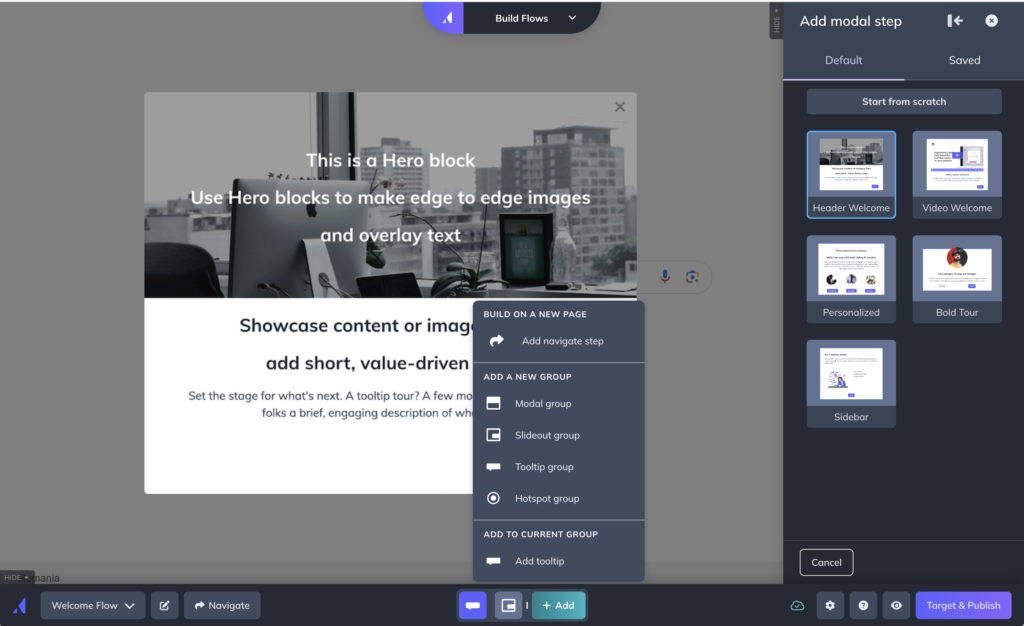
- Checklists: You can also create checklists with Appcues (NOT available on the Essentials plan) and prompt users to take action. These are ok but have limited functionality (you can’t trigger JS functions or add gamification elements) compared to alternatives, such as Userpilot.
- Segmentation: You can use one of the pre-defined audience segments or create customer segments based on plan tier, lifecycle stage, and other factors. It’s possible to target individual segments with personalized messaging and journeys.
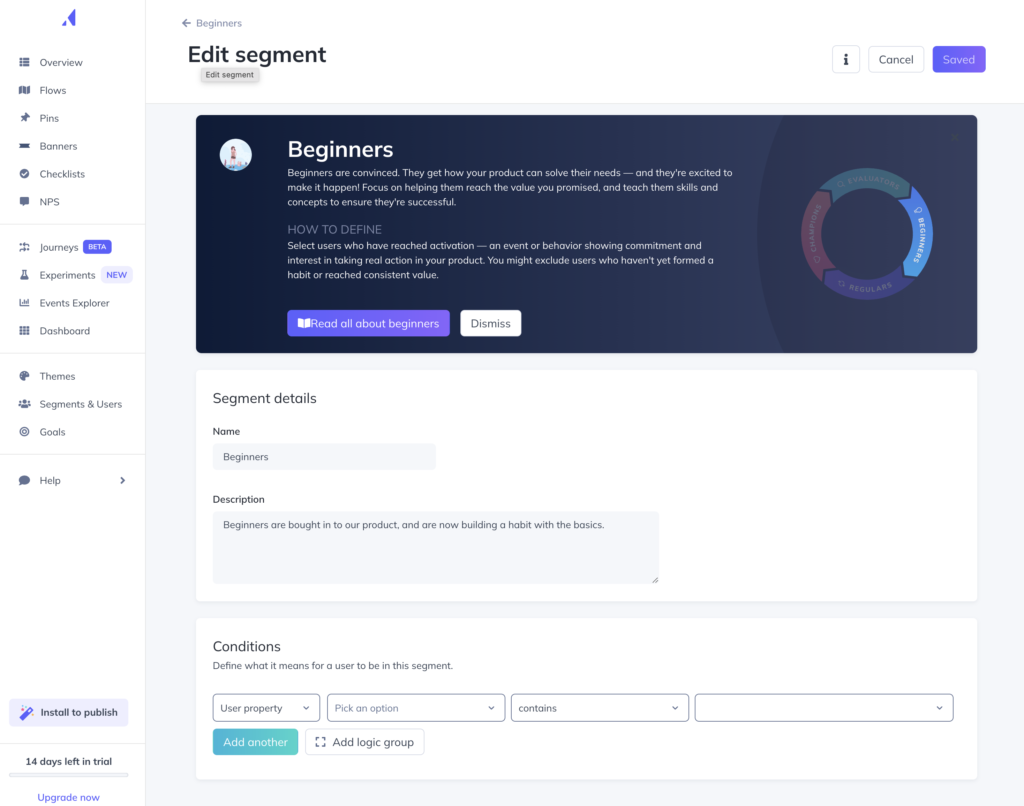
- Measure and improve: You can track in-app flow performance and measure events (limited to 5 on the Essentials plan) to identify areas of improvement.
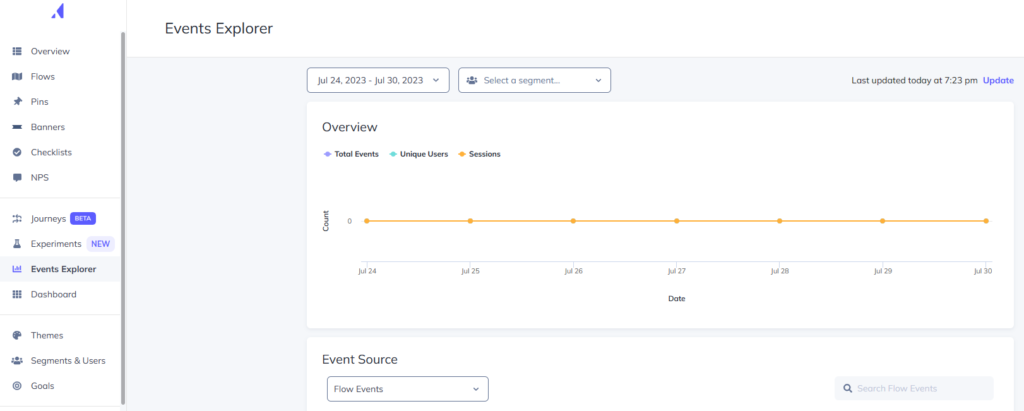
- Test and optimize: The newly introduced A/B testing feature lets you test different onboarding flows. You can compare the performance of different in-app sequences, identify the best-performing ones, and refine onboarding flows.
Appcues for product analytics
Besides creating onboarding journeys, Appcues also helps you monitor product adoption and user behavior. The best part here is that you don’t need any coding experience to set up product analytics on Appcues.
Note that since Appcues doesn’t focus on analytics, the features it offers are limited. If you need access to cohorts, retention analysis, funnels, paths or trends, you will need a different tool.
Appcues offers the following features for tracking product usage analytics:
- Click-to-track: Available in Appcues Builder – the Chrome Extension, this feature lets you define and track new events by using feature tags, such as when a user fills a form field or hovers over a menu. It gives you insight into how users are engaging with your product’s UI.
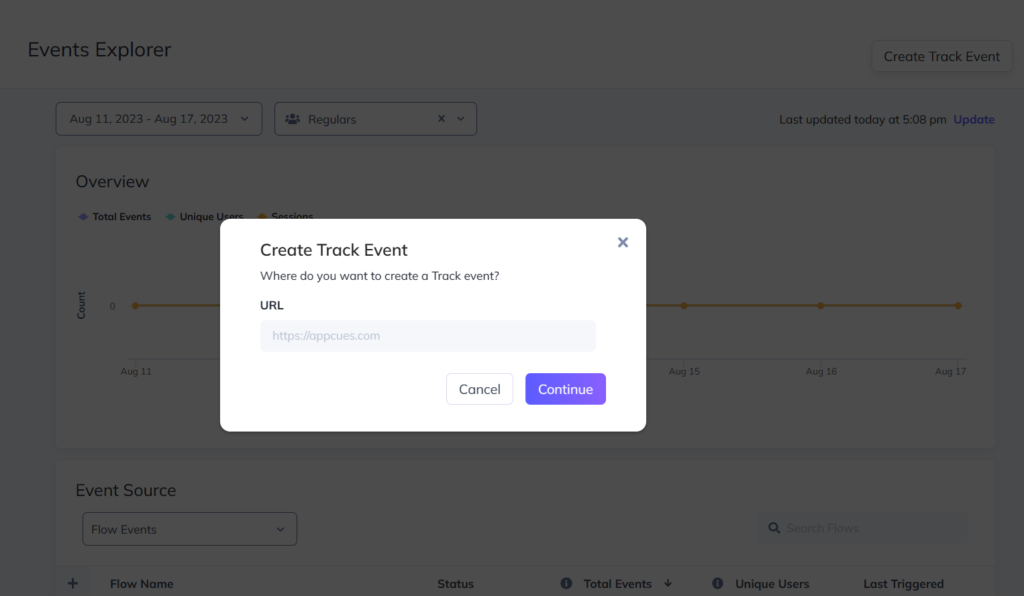
- Events Explorer: Available in Appcues Studio – the main dashboard, Events Explorer lets you validate and visualize various events, making it easier to measure product adoption and user engagement over a given period.
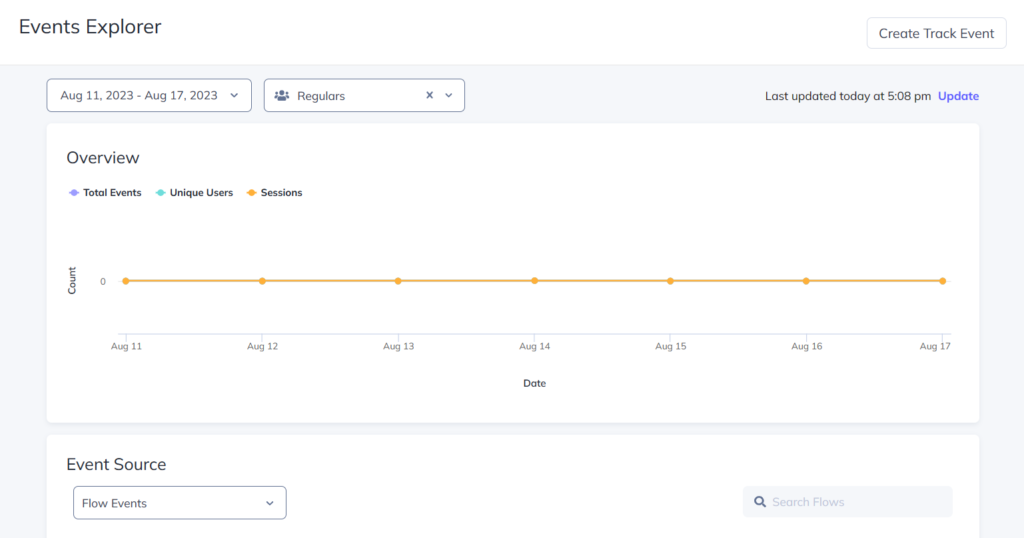
- Appcues also offers integrations with analytic tools like Amplitude if you need more data tracking.
- You can also track flow engagement analytics using Appcues, but this will only tell you how well your in-app guides are performing and how users engage with them.
Keep in mind that Appcues’s element detection algorithm isn’t the most powerful. Platforms like Userpilot do a better job at tracking user engagement for specific in-app elements, on top of offering more advanced analytics features like funnels, trends and cohort analysis.
Appcues for self-service support
Appcues is primarily designed as a tool to facilitate user onboarding through personalized product tours and walkthroughs. There are a few features you can use to provide self-service support, too.
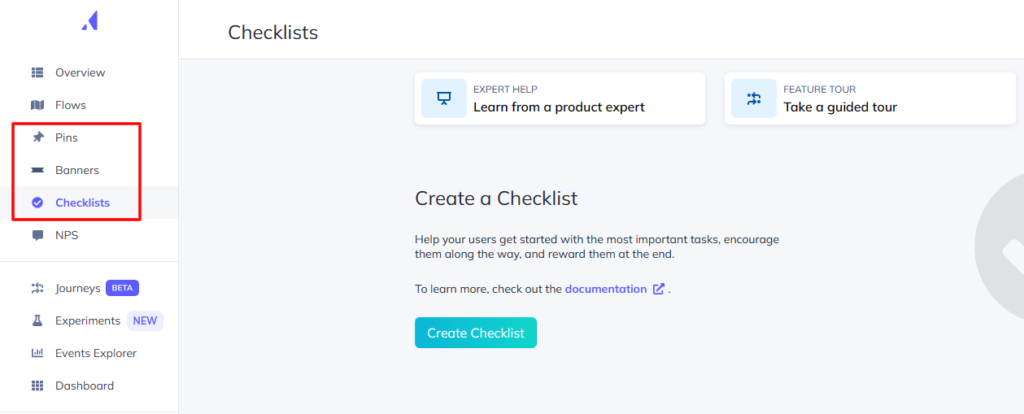
These include:
- Launchpads: With Launchpads, users can access various Appcues flows from a dropdown notifications menu. You can use them to create a robust resource center within your product. That, in turn, lets users troubleshoot common problems on their own.
- Checklists: Checklists let you create contextual in-app walkthroughs that familiarize users with different product features. Combining them with other UI patterns like modals, hotspots, and tooltips can help enhance self-service support.
- Pins: Pins appear as always-available tooltips and buttons that let you provide constant hand-holding to new users.
It’s worth noting that Appcues, as a standalone tool, can’t help you provide complete self-service support. You’ll need other elements, such as AI-powered chatbots and FAQs, to empower users.
Pricing of Appcues
Pricing for Appcues starts at $249 per month, with the platform offering three distinct tiers – Essentials, Growth, and Enterprise.
The total cost can vary depending on the number of monthly active users (MAU). For instance, the Essential plan starts at $249 per month for 2500 MAU but jumps to $299 for 5000 MAU.
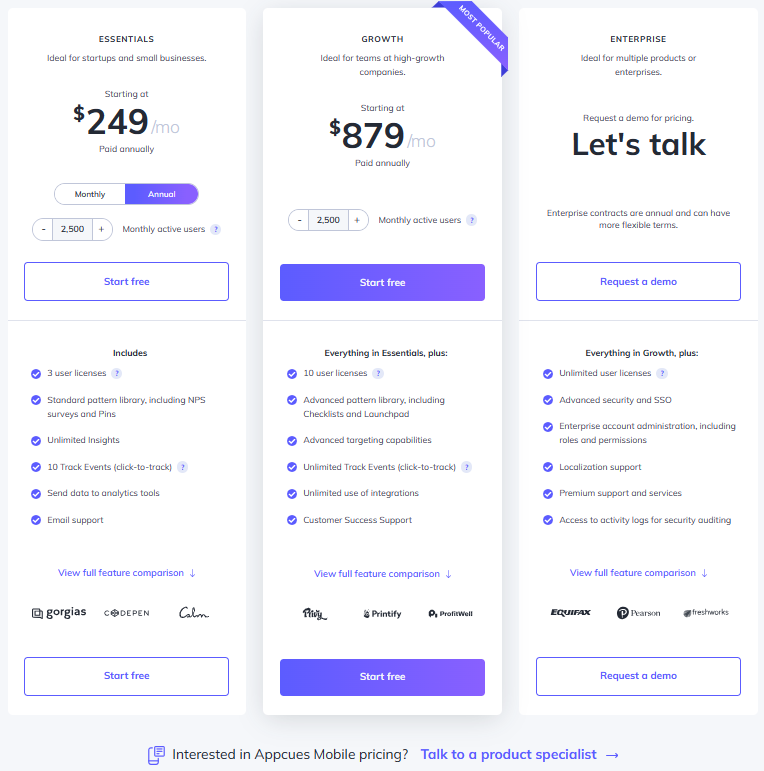
Here’s a detailed glimpse of the different pricing tiers:
- Essentials: It’s the basic tier that starts at $249 per month. It includes 3 user licenses and lets you add up to 5 audience segments. Some UI patterns, such as checklists, launchpads, and custom CSS support, aren’t available. Customer support is only available through email.
- Growth: This tier starts at $879 per month (for 2500 monthly active users) and includes 10 user licenses. You can target unlimited audience segments and use the full spectrum of UI patterns. Additionally, you can access the Premium Integrations package, which includes integrations with Slack, Salesforce, Marketo, and Zendesk.
- Enterprise: This is the most feature-packed tier and includes robust security controls like role-based access and activity logs. It’s also the only tier that comes with multi-account and localization support. Besides email and phone support, you also get a dedicated Customer Success Manager and Technical Implementation Manager. Pricing is available on request.
All three plans come with a 14-day free trial, where you can test unlimited flows and track up to 5 events. You can extend the trial by another 14 days by installing the Appcues SDK in your app. Additionally, you don’t need a credit card to sign up for the free trial.
Keep in mind that the above pricing plans are applicable to web apps. Pricing for Appcues Mobile is available on request.
It’s also worth noting that Appcues is pricier than some of the other product adoption tools available in the market, including Userpilot. For instance, Userpilot’s basic tier (Starter) lets you add up to 10 audience segments and includes the complete set of UI patterns.
GainsightPX vs Pendo
There are many ways how Pendo is different (and in a lot of ways better!) from GainsightPX. Let’s explore the features of Pendo, how it’s better than GainsightPX, and how it may fall short too.
Pendo for user onboarding
Pendo is a product adoption platform that has the usual onboarding features that are commonly included with similar solutions. However, those using Pendo Free will need to note that they’ll need to find a new onboarding solution once they cross 500 MAUs or upgrade to the paid version.
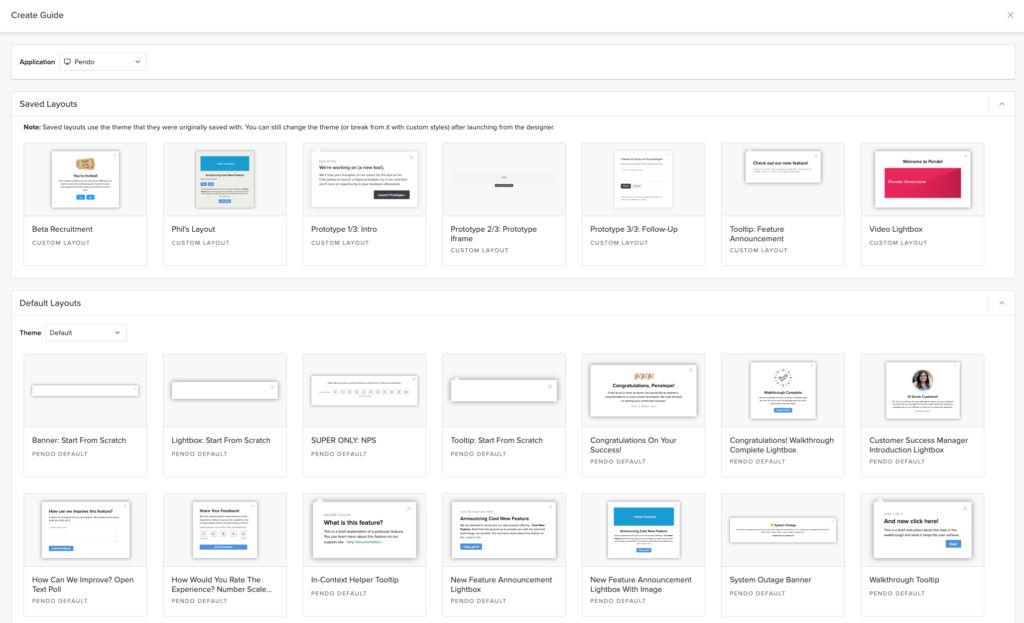
There are a few ways you can use Pendo to improve your new user onboarding flows:
- Guide Layouts: Pendo has layout templates for lightboxes, banners, and tooltips that you can use to build onboarding flows for new users.
- Flow Triggers: Pendo’s guide activation options let you trigger an onboarding flow when new users land on a particular URL, use a specific device type, interact with a tagged element, or match the target segment.
- Localization Settings: Localization settings can stop an onboarding flow from triggering if it hasn’t been translated into the user’s chosen language. Because Pendo has no AI-powered localization features, you’ll need to upload language CSVs manually for this to work.
- Onboarding Module: You can add the onboarding module to your in-app resource center in two clicks then change the color, text style, and progress icon to align it with your product’s brand palette.
Pendo for product analytics
Pendo has no shortage of product analytics capabilities as both native features and third-party integrations. You’ll even be able to access the most important metrics like MAUs and feature use from the home dashboard itself.
Here’s a closer look at Pendo’s analytics features:
- Native Analytics: Because Pendo is a product adoption platform, most of its adoption and engagement analytics are native to the solution. This means you’ll be able to track the number of views, clicks, and interactions that specific in-app guides or product areas get.
- Paths: The Paths section of your Pendo account shows you which paths users take when coming from a specific page or which path they took to get to a particular page. You’ll also be able to sort this data by segment, date, or see the paths taken by individual visitor IDs.
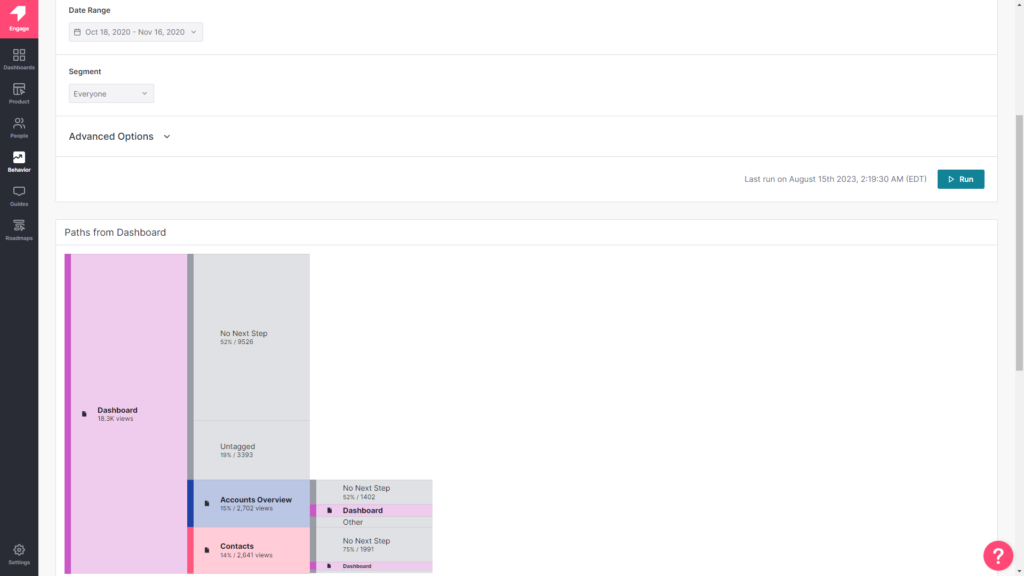
- Retention: Pendo’s retention analytics dashboard lets you see cohort retention data from month to month. You’ll also be able to toggle between visitors versus accounts, switch between weekly or monthly views, and measure retention for specific segments.
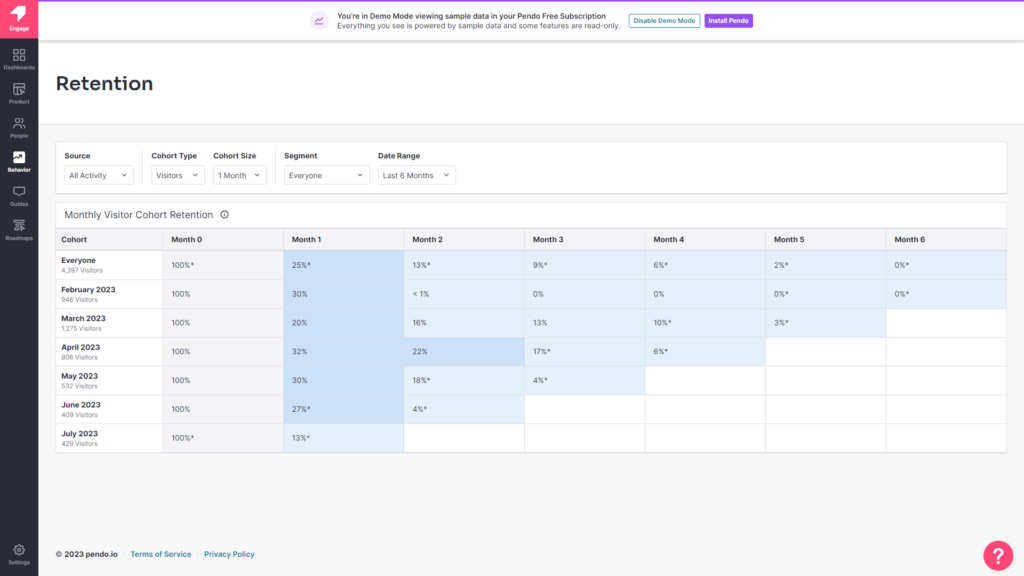
- Funnels: Pendo’s funnel analytics can tell you how many unique visitors have seen your funnels, how many attempts have been made to get through the funnel, and the average time it takes to complete the funnel. You’ll also be able to see completion rates and sort by date or segment.
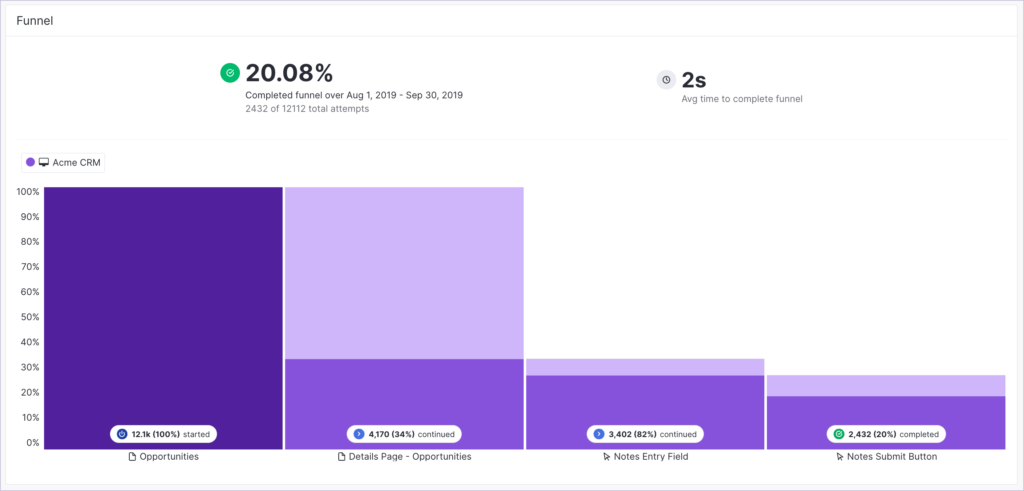
- Analytics Widgets: Pendo’s home dashboard lets you choose which widgets you’d like to add or remove. You’ll be able to select from various analytics widgets that track product goals, feature adoption, guide views, time-on-app, and other core metrics.
- Third-Party Integrations: Pendo has integrations with tools like Salesforce, Intercom, Segment, Slack, and more. Linking your Pendo account with these third-party solutions will make syncing and sharing data seamless (but do note that Pendo doesn’t update analytics in real time).
Note: Pendo’s HubSpot integration is a one-way integration, which means you won’t be able to sync data both ways between the two tools. You’ll need to upgrade to the Growth plan or higher to use Pendo integrations.
Pendo for self-service support
Self-service support is a must-have for any SaaS company.
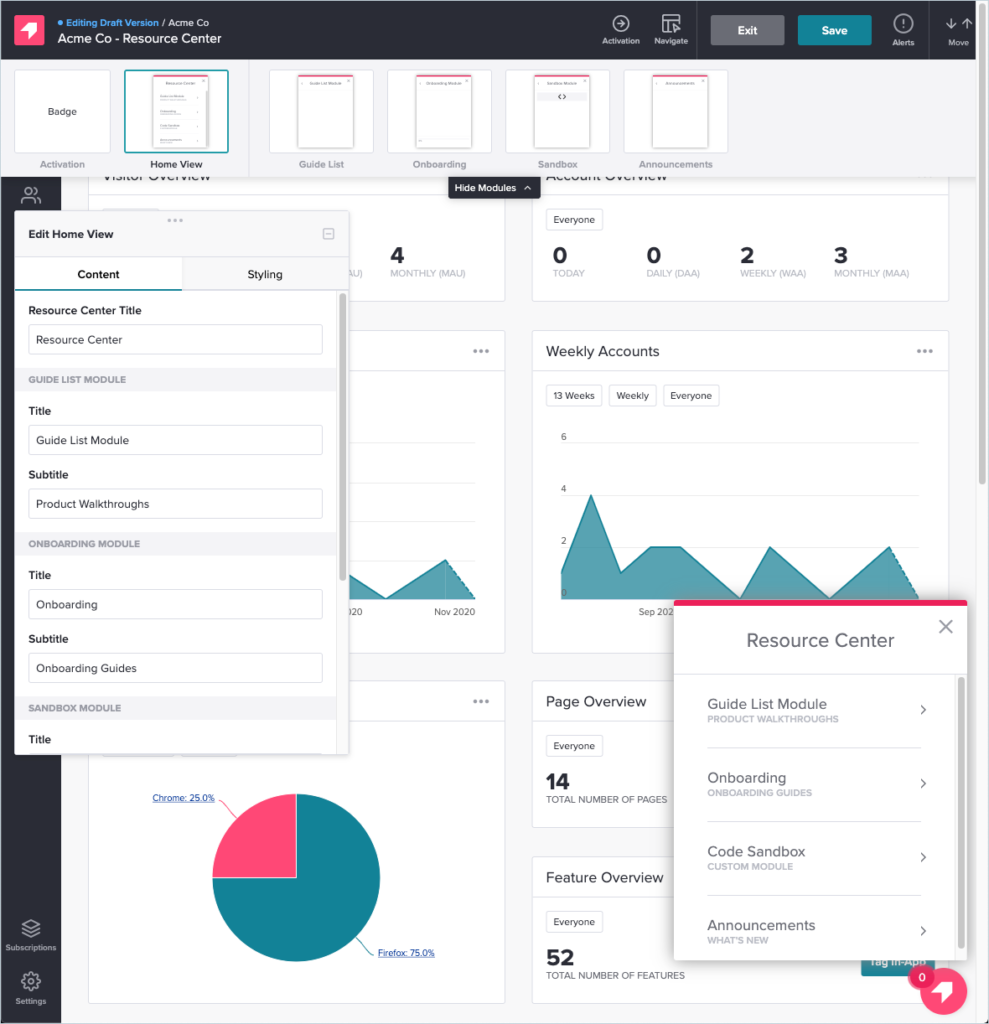
Here are the best Pendo features to use for self-service support:
- Resource Center: Pendo’s in-app resource center can serve as a self-service portal with different modules for each stage of the user journey. Create a dedicated section for onboarding resources or segment the visible modules so users only see the most relevant guides.
- Tooltips: In addition to educating new users, tooltips can also be used to link to product documentation, onboarding resources, and tutorial videos that will help your customers solve their own problems.
- Live Chat Integrations: When you integrate your Pendo account with either Drift or Intercom, you’ll be able to embed a live chat widget within the in-app resource center. This is very helpful for customers who try to solve a problem themselves but realize they need real-time assistance.
Note: You’ll need to upgrade to the Complete plan or higher to use Pendo integrations and resource centers.
Pricing of Pendo
Pricing for paid Pendo plans is only provided on a quote basis and there are no listed price ranges on the solution’s website. That said, certain reviews have stated that prices start at upwards of $20,000 per year for a single product and more than twice that for higher plans.
Pendo has two paid plans and one free version that is limited to 500 MAUs which makes it accessible to startups but difficult to scale in the long run.
Here are the differences between each Pendo plan:
- Pendo Free: The free version of Pendo can accommodate 500 MAUs and has features like native analytics dashboards, feature tagging, event tracking, segmentation, NPS surveys (with Pendo branding), analytics reports, and in-app guides.
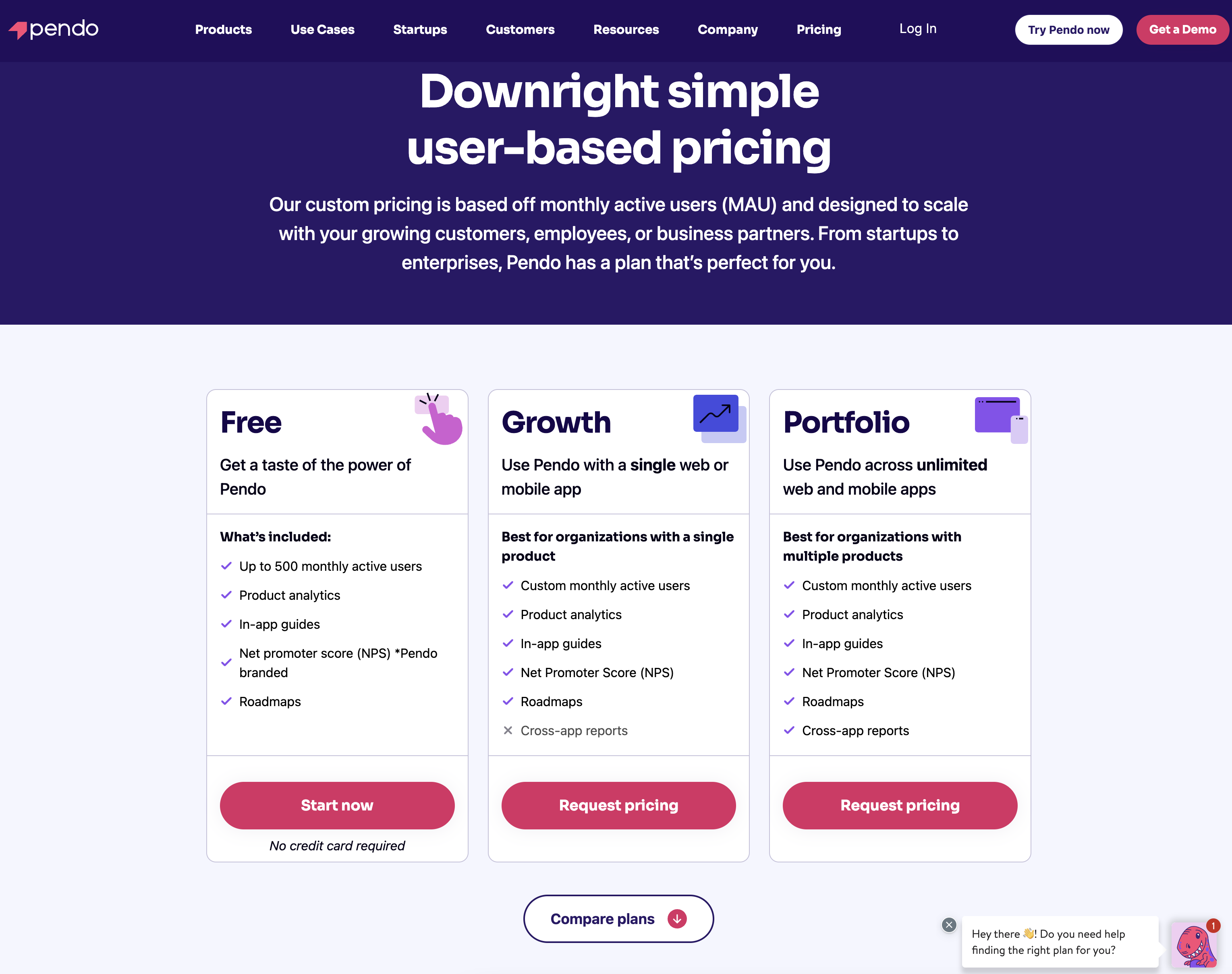
- Growth: Pendo’s Growth plan is designed to be used for a single web or mobile app but can accommodate a custom number of MAUs. It includes features like native analytics dashboards, in-app guides, NPS surveys and response tracking, and customer support.
- Portfolio: Pendo’s Portfolio plan is targeted towards customers who want to use the tool for multiple web and/or mobile apps. Features include guide experiment capabilities, cross-app executive dashboards, cross-app journey reporting, and access to product engagement scores.
GainsightPX vs Chameleon
There are many ways how Chameleon is different (and in a lot of ways better!) from GainsightPX. Let’s explore the features of Chameleon, how it’s better than GainsightPX, and how it may fall short too.
Chameleon for user onboarding
Users expect to be shown the red carpet with a welcome tour for your product. Chameleon helps you create welcome tours that gets users beyond their first “Aha”.
Here are some features of Chameleon for new user onboarding:
- Segmentation: You can use custom segments to show a sequence of your product tours over time. The hyper-targeted onboarding flows are tailored to your users’ needs. Here’s a short example of what the tour session can look like:
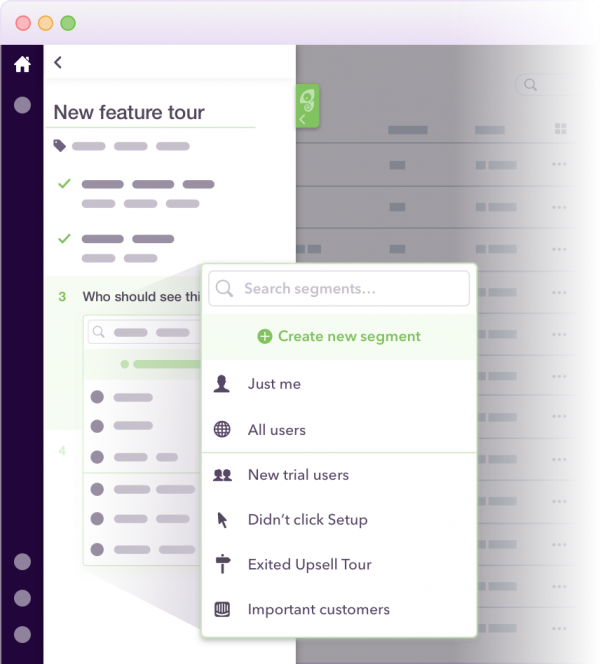
- Clear Analysis: Easily assess and optimize your user onboarding tours with real-time data.
- Launchers: Build onboarding checklists, including items like Loom videos and knowledge base articles to help users unlock more value.
- Customization options: Enjoy fine control over where the onboarding flow appears, choose who sees it, and define how users can interact with it.
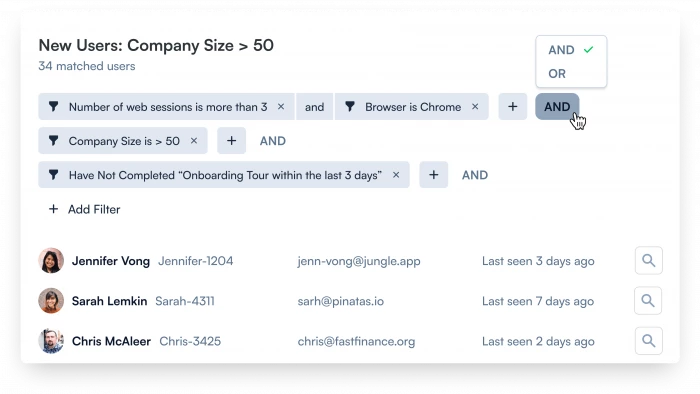
Spoiler alert: when you subscribe for the Starter plan, you get access to just one launcher which is very limited for many onboarding use cases. However, you get unlimited access when you pay an extra $971 for the Growth plan.
Chameleon for product analytics
Here’s a breakdown of Chameleon’s standout features in the context of product analytics:
- Seamless Integrations: Chameleon offers seamless integration capabilities, granting you access to best-in-class user analytics tools such as Segment, Mixpanel, Heap, FullStory, and more. This interconnectedness enhances your capacity to harness a comprehensive view of user behavior.
- Comprehensive Tracking: Chameleon excels in tracking various events throughout your user onboarding process. From tracking tour initiation and completion to monitoring button clicks and user exits, Chameleon provides real-time insights into your product tours. This level of granularity ensures you stay attuned to every user interaction.

- Efficient Data Collection: Simplify data collection through Chameleon’s data schema, easily managed via Google Sheets. This streamlined process ensures that you capture and structure essential data effectively, empowering your product analytics endeavors.
In essence, both Userpilot and Chameleon offer robust solutions for user analytics. However, Chameleon takes the lead in the realm of integrations with top-tier user analytics tools. This integrative approach enhances your ability to harness the full potential of your product analytics initiatives.
Chameleon for self-service support
The self-service methodology focuses on giving users the tools necessary to solve some problems on their own without having to reach out to support agents. This often includes elements like knowledge bases, chatbots, and interactive walkthroughs
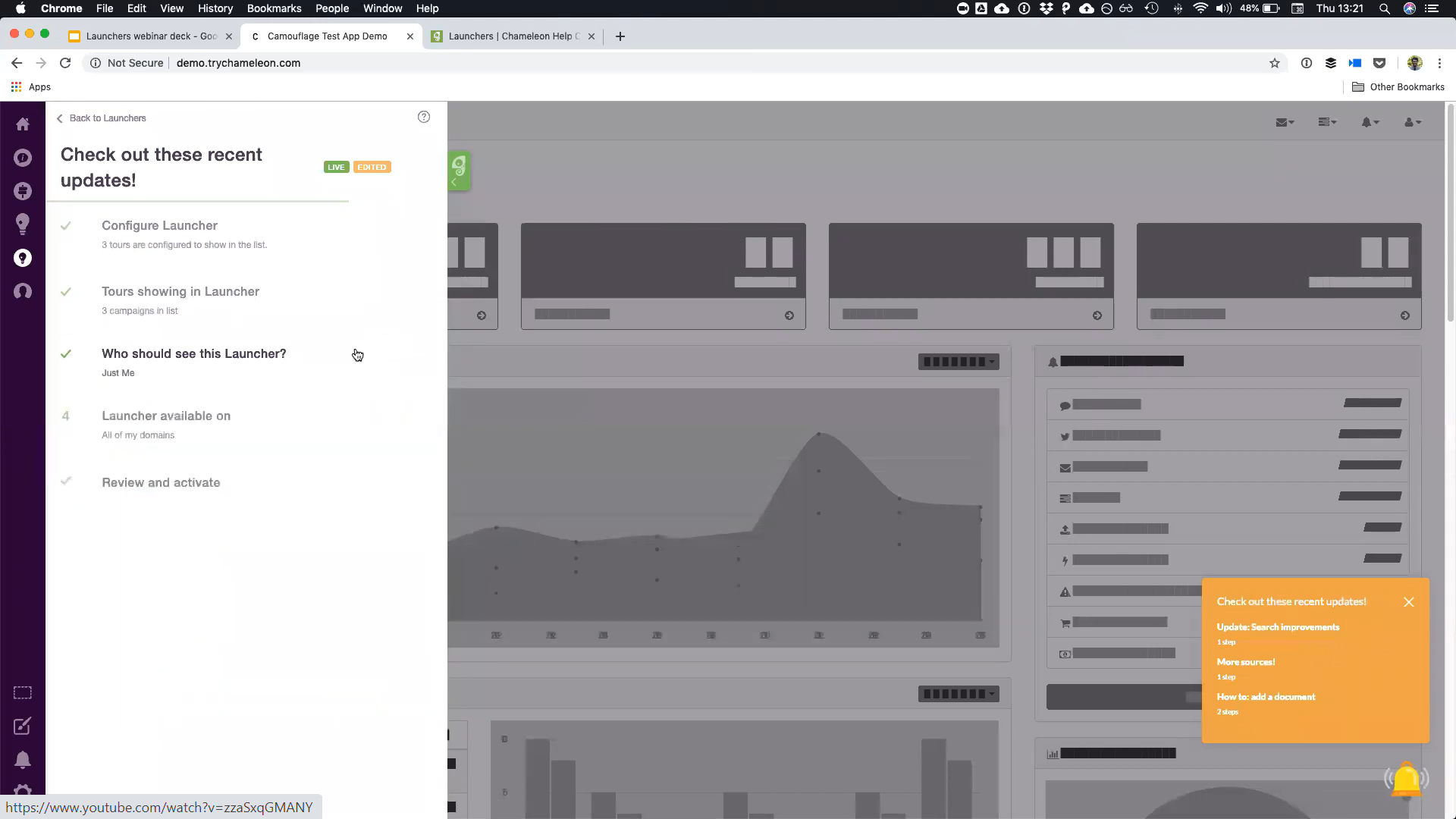
Here are Chameleon features that will help you provide self-service support for SaaS companies:
- Tooltips: Tooltips help users understand unfamiliar or complex parts of your product when they need it the most. It keeps your UI simple by reducing the noise or the need to explain everything within your interface. Since your users may have different levels of expertise and backgrounds, they may not find everything in your product intuitive, you can use hover tips to explain certain product terminologies and elements in your workspace.
- Help widgets (self-serve widget): The self-serve widget (resource center in Userpilot) clarifies where users can get help and what resources are available. Through launchers on Chameleon, you can deploy a self-serve widget out of the box. By showing customized Launchers based on the feature the user is currently using, you can deploy custom and interactive self-serve support across your whole product without pushing users off track to an external knowledge base.
- Interactive product tours: One of the best ways to offer users self-serve support is by allowing them to take interactive product tours at their own pace. You can educate those ready to learn something new while letting other users take it later when they may have more time or are ready to engage further with your platform.
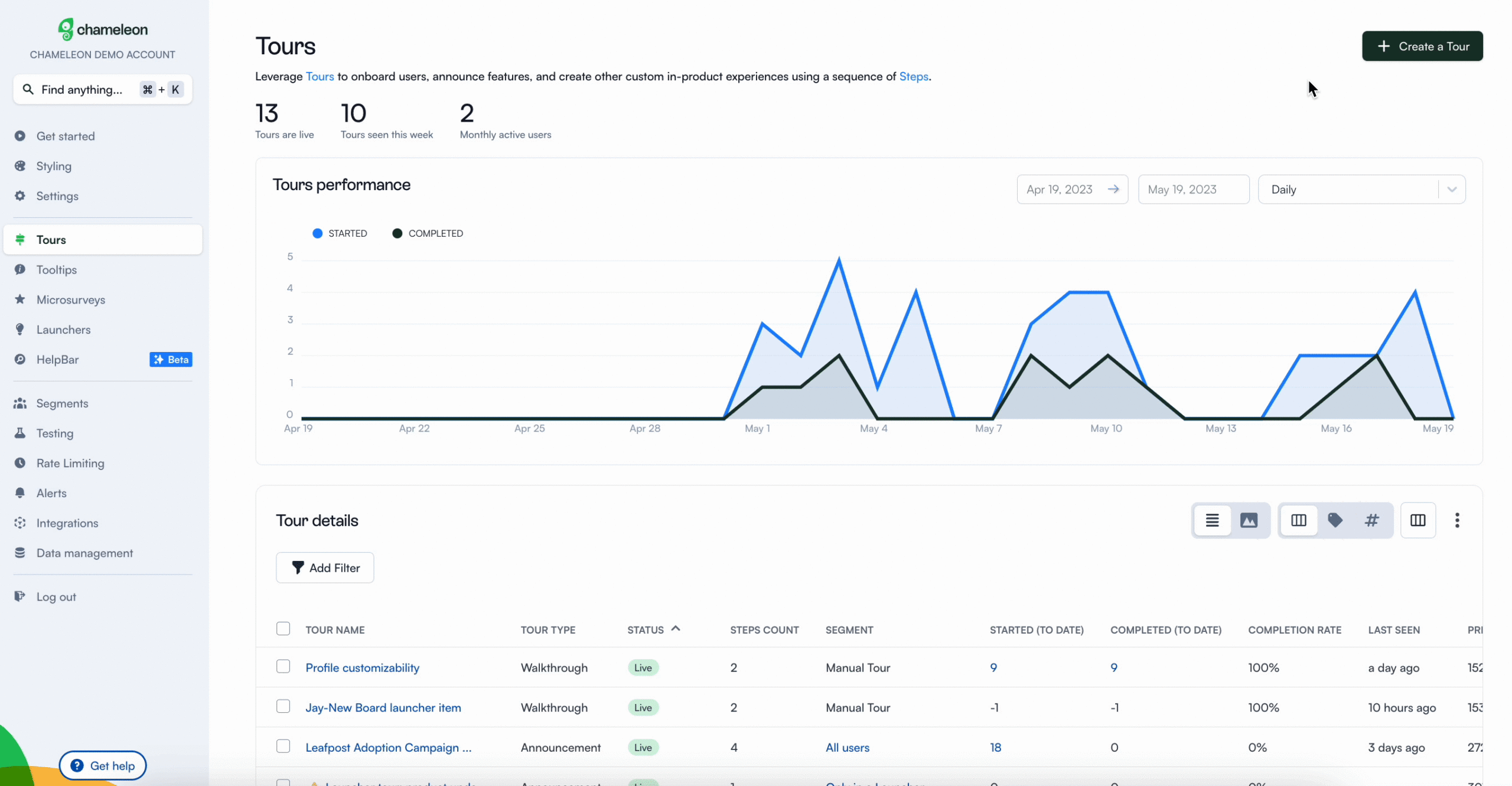
Pricing of Chameleon
Chameleon’s pricing is based on your product’s monthly users. From the Startup plan (for small companies to get started and save) to the Growth and Enterprise plans (for larger organizations with advanced requirements) billed via invoice.

Here’s an overview of the pricing plans, and features of each plan:
- Help Bar: This is a standalone search function on top of your product, allowing users to search your knowledge base articles.
- Startup plan: For small companies to get started. Fee: $354/month, billed Monthly, usage-based, Unlimited Tours and tooltips, 5 microsurveys, 1 Launcher, Custom CSS.
- Growth plan: For growing businesses to drive returns quickly, from $1350/month. Everything in the startup plan, plus: unlimited microsurveys & launchers, A/B testing, and rate limiting is paid annually with bulk pricing.
- Enterprise plan: For larger organizations with advanced requirements. The fee for this plan is not stated on the website rather, you get to talk to the team. You get everything in the growth plan, multi-product account, user permissions, localizations, and SSO/enhanced security.
The Growth plan seems to be the real deal because of the exciting features that can boost your product marketing. For example, you can’t get the rate limiting feature on the Startup plan, including A/B testing. These are relevant and powerful product adoption weapons that should be in your arsenal if you truly want to win more users.
Is the startup plan expensive?
Yes, compared to Userpilot, about a $170 difference. It’s best to opt in for the Growth plan for the juicy benefits, where you pay $1350 annually rather than paying a whopping $5000+ yearly for the startup plan.
Conclusion
As you can see, there are many different competitors and alternatives to GainsightPX. We’ve discussed a few above – but which one is the best?
The answer is “it depends” – but we strongly believe that if you’re a mid-market SaaS company looking for a great user onboarding and product analytics tool, Userpilot is the best option for you.
Hopefully, you found this post helpful. And if you need any help with how Userpilot is different, schedule a demo to get started!


